Yesterday the Kennedy Tree Group ( the KTG ) put all their cards on the table and revealed exactly why they believe they have identified the place where the Stringybark Creek police campsite was in 1878. They have found four trees in 2019 that in their opinion look like four trees seen in photos of the site in 1878. One of the two 1878 photos is above. Its a bold claim to make given that the photos are blurry and indistinct, and trees can change a lot in 141 years, but it cannot be overstated, that their entire claim stands or falls on being able to prove that the trees they’ve identified in 2019 are the very same trees seen in the photographs. If we can be sure they’ve found those exact trees, we can be sure they’ve found the Campsite, but if we cant be sure then they don’t have a case.
Lets look carefully at the tree they’ve labeled PC1, and called the Teapot tree. They have called it the teapot tree because the shape of the first branch coming off the main trunk. on the left, looks like a teapot spout. Below is the 2019 Teapot tree and beside it for comparison a close up of the 1878 tree:
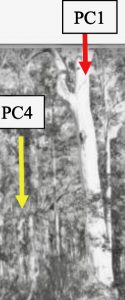
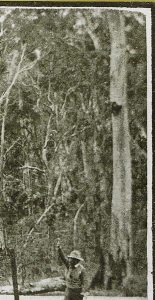
I think they’ve got it wrong. For one thing, the lateral profile of the trunk well above the level of the branch node in the 1878 photo is clear and straight and uninterrupted, with no obvious branches coming off, but in the 2019 teapot tree theres a very substantial branch coming off – thier ‘teapot branch – thats easily seen, not far above the branch node mark. This is a significant and very obvious difference. I don’t see how that huge difference can be explained away!
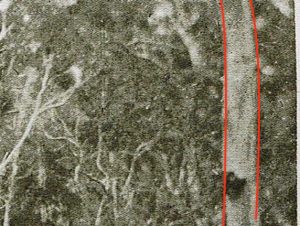
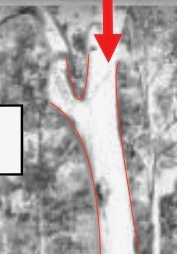
In the 1878 photo theres a glimpse of a branch hidden almost completely by foliage, and the KTG think this is the ‘teapot branch’ but it is not possible to actually see a direct connection between this supposed ‘teapot branch’ and the teapot tree trunk : that connection has simply been assumed to be there by the KTG – but if such a connection exists its obscured by vegetation which is clearly behind the teapot tree. In fact, the presumed teapot tree branch could just as easily and with equal justification be seen to be a continuation of a tree that is leaning across behind the teapot tree and whose trunk can be seen on the opposite side, lower down. The ‘teapot’ branch and this other trunk are in perfect alignment as seen below:
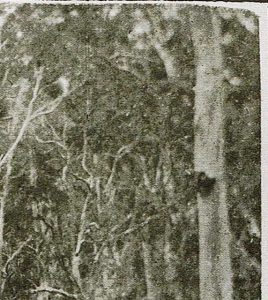
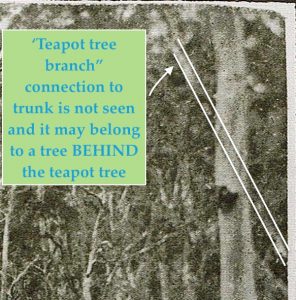
The suggestion that the ‘teapot branch’ is actually part of a different tree altogether is supported by what can be seen by looking at the OTHER Burman photo of this tree, taken from a slightly different angle and revealing there is indeed a tree angling across from behind it:
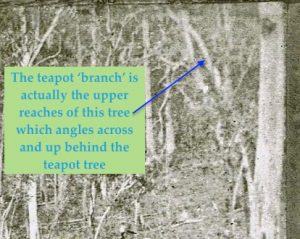
The other thing the KTG claim links the 1878 PC1 to the teapot tree is the ‘branch node’. This was called a ‘burl’ by the CSI team and they claimed it was visible in a different tree a couple of hundred meters south of the teapot tree. So is it a burl or a branch node? In any case, if these things are commonly found on gum trees and it seems they often look similar, who can be certain the the one on the Teapot tree is the same one seen 141 years earlier on PC1 in the Burman photograph? They dont look exactly the same so could anyone swear it was certain they were? The answer is no.
The other problem with this branch node or burl is the distance between it and the place where the teapot tree branch is supposed to join the trunk : it looks a lot closer in the teapot tree than it is in the Burman photograph. I didnt think as a tree grew older and bigger these two things would get closer together.
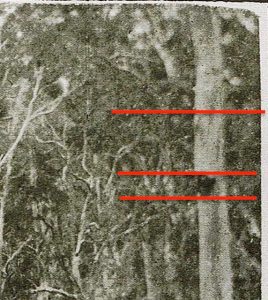
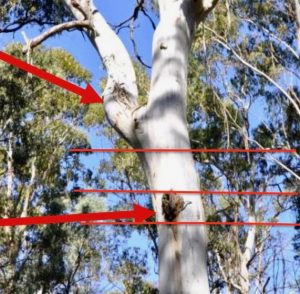
SUMMARY:
- The 1878 photo does NOT show a ‘teapot branch’ attached to PC1 ; the claim there is such a branch attached to PC1 is speculation. In fact the supposed teapot branch is probably part of a tree behind PC1.
- The trunk of PC1 ascends straight up beyond the ‘branch node’ with no evidence of any branches coming off it, whereas the Teapot tree trunk has a large and prominent branch coming off it just above the ‘branch node’.
- The other Burman photo shows a slender trunk angling across behind PC1 and where seen behind PC1 is misinterpreted as being part of it.
- The distance between the branch node and where the teapot branch is assumed to be connected to the trunk of PC1 is apparently less in the teapot tree than in PC1 which is the opposite of what would be expected in a growing tree.
CONCLUSION:
The case for the teapot tree has not been made. It relies mostly on an assumption that a short segment of a branch glimpsed among foliage in the 1878 photo is part of PC1 but there is no photographic evidence that it does. There is photographic evidence that suggests the teapot branch is part of a different tree altogether.
Branch node markings are common, and there has already been an assertion that the one on PC1 is seen on a different tree altogether. However, because none of them are identical it cannot be asserted with any authority that the PC1 node is the one seen on the teapot tree.
The KTG case for PC2, PC3 and PC4 will be examined in the next few posts.
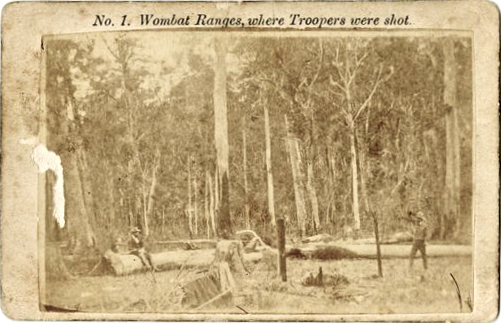
For those wanting to download the Kennedy Tree Report, it is on the Greta Heritage Group website at http://www.gretaheritagegroup.com.au/stringybark-creek/
Importantly, there is another download document there, which presents the groups’ findings about the location of the Stringybark Creek police camp site.
From a quick look over it, it seems the group located what they claim is the Kennedy Tree first, then worked from that to discover what they claim is the police camp site.
This is all outside my ability to comment on as regards any locations. What is interesting, though, is the SBC camp report’s introductory comment that the Burman photo “is a re-enactment by police a few days after the shootings.” Maybe, but I thought I read that it was a re-enactment by the photographer and others, but none of them police. (Needs checking.)
Anyway, the point is that the report says, “The authors agree with Bill Denheld’s corrections to McIntyre’s map of the campsite layout allowing for the north-south log to be two logs running NE to SW.” I continue to have problems with people disagreeing with McIntyre’s annotated map of the event that he witnessed, including plotting its orientation.
I think it is possible that too much weight has been given to the positioning of the actors placed in the photograph by Burman – one representing Ned Kelly crouched behind a log; the second representing McIntyre sitting on a log, and the third walking forward from the right.
I suspect Burman may have placed his actors where they would make a good photograph around the actual logs, but not necessarily, or even at all, where the persons they represent stood in real life.
That potentially puts a whole new set of possibilities up about the orientation of the posed photo, which seems to be being argued based on where the actors are standing, rather than where McIntyre described their various positions and orientations on his heavily annotated sketch map. Is this something else to consider in regard to arguments about orientation?
Thanks Stuart. Burman didnt leave any documentation to assist in working out the orientation of his photos so we have to figure out what seems logical. He was shown the place only a few days after the events by people who went there with the original search party which included McIntyre. Clearly he was shown where Kennedys body was found and no doubt also would have been shown where Lonigans and Scanlans were, as well.
The reasoning that make most sense to me. -and the KTG and Bill – is that if he had placed the actors exactly where they were at the time of the attack he wouldn’t have been able to get them all in one shot , so he moved them all in closer to each other, but more or less in the right orientation. Bills analysis of shadow angles supports the view that they were roughly facing north – whereas Adam Ford and the CSI team thought the opposite, mostly I think because they have decided for no reason that I know of that Burman took the photos from where the police tent was.
As Ive said before, I can think of no good reason why Burman wouldn’t have wanted to make his photos as accurate as possible, because that would enhance their commercial value and his reputation.
The supporters of the CSI site and Adam Fords site are not going to be able to accept the KTG claim about the Police camp site unless they first of all do an about-face on their stance regarding the orientation of those photos, which will be embarrassing for them because they’ve argued tooth and nail for years that Bill had the orientation wrong.
One other thing – have the KTG made the case for PC1 being the teapot tree? The absence of that thick branch coming off the side just above the ‘burl’ or ‘branch node’ is fatal to their claim in my view. Its not valid to work backwards from the 2019 tree and say there must be one there, even though you cant see it.
The Kelly Gang Unmasked remarks:
Forensic photography was in its infancy, but police in Melbourne
had also begun the practice of photographing crime scenes. A
collection of these glass plate negatives built up gradually but so
far as is known has not survived in its entirety. But a professional
photographer recorded images of the Stringybark Creek crime scene.
He used imagination and re-enactment to render immediacy and
theatre to his photographs.
This photographer was Frederick Burman, whose business
address was in Bourke Street in Melbourne, with another studio at
Beechworth. In one photograph he commented: The photo provided
is a picture of the ground where Constables Lonigan and Scanlan
were shot. took it myself. The place was pointed out to me by Mr
[Edward ] Monk. The spear grass in the neighbourhood is about six or
seven feet high. Police Sub-inspector D. Kennedy, who had taken
Burman ’s short statement, noted that ‘Monk was with McIntyre when
the bodies of Lonigan and Scanlan were found. McIntyre identifies
the photo and draws attention to an upright post the remains of an old
hut, see right and corner of picture.’ Eventually a series of eighteen
photographs resulted that took viewers directly to both the murder
scene and Glenrowan, using Burman’s work plus further images
taken by photographer Oswald Madeley. Citizens could buy these in
Melbourne and elsewhere. This was a ground-breaking pictorial news
scoop. Evidence collected later for the trial of Ned Kelly included the
Burman photograph of the Stringybark Creek murder site mentioned
above.
The Kelly Gang Unmasked, pp.83, 84.
At the trial of Ned Kelly no official shorthand notes or transcripts were
made. This has caused major problems in analysing the case today.
Most court reporters were able to use shorthand, but their reports
were abbreviated for reader impact and did not pretend to be word-
for-word accounts of the whole trial.
…To make matters worse, comparison of the trial reports in The
Age, the Argus, the Herald and The Ovens and Murray Advertiser (which
sent its own reporter to the trial) show wide differences in the wording
of vital evidence. Generally, the reports in The Age were more detailed
(or less edited) than those in The Argus . Problems arise when there are
differences in the phrasing of particular evidence relating to a major
issue. No one today can say which version is correct.
The Kelly Gang Unmasked, 119, 120.
Aaaarghh!
Cam West
Stuart, interesting discussion, I’d like to add, when Kennedy was found it is recorded his body was on the opposite side of the creek from where Scanlan’s body was found, and that was just north of the police camp, and we know just near the bridle track which ran along the west bank of SBC. I have followed the evidence of it years ago and is still to be seen.
David, I appreciate your support as any clear thinking Kelly student would need some very compelling argument to suggest trees in a photo grouping as seen against a steep rising slope could be so far apart to make them invisible to the photo viewer. You have discussed the PC1 tree an important part of their report, but PC4 is a doozy. They show its about 70 odd metres into the Burman photo but no one I have asked can see anything like it. I spent a bit of time preparing this image using Google Earth at ground views. So here is the twisty PC4 tree that they- with Jim Fogarty can see in the Burman photos. I can appreciate Jim is new to this research, and no wonder his interest because he is G G G Grandson of Ewan Tolmie who had Hollands Creek run just south of Fern Hills run on which SBC was located. It was a son of Tolmie that informed the police the where abouts of the Kellys that led to the man hunt for them, that ended with the police getting shot.
Attachment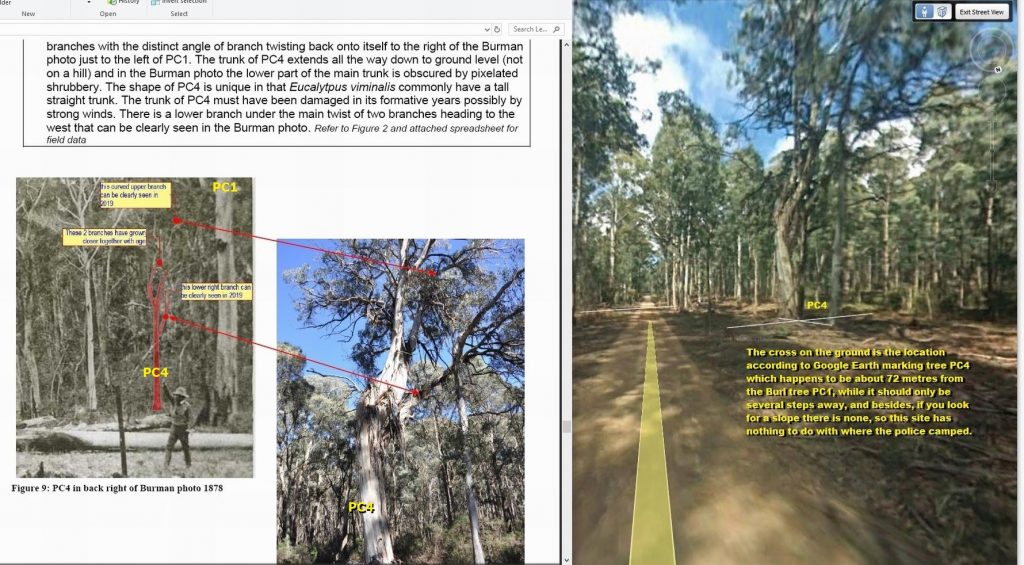
The actors are not in the correct positions even IF they were deliberately placed facing north. Burman could have moved his camera more to the right of the scene and captured them closer to the correct positions while still having the sun behind him IF the sun was coming from the right hand side.
Who knows the actors could show the direction Scanlon and Kennedy came into the camp. The man with his hand raised could represent McIntyre. This would better fit the locations given by McIntyre and his sketch map. In any case the actors are not in the correct spots which ever way it is looked at.
It is more probable that they were just placed to add a bit of drama to the photos. Nothing to do with enhancing any commercial value to the photographs as they would sell anyway. I agree with Stuart, too much weight has been placed on the positions of the actors in the photographs.
Jeremy Collins
Hi David and Jeremy, I’m just throwing the possibility that the actors were placed to secure a good phot at the scene into the mix. What we have is a nice panorama shot of the location. But I think we have to allow that McIntyre is represented sitting on a log, with Kelly shown covering him and also able to sight the standing man. That is consistent with McIntyre’s statements. I am not trying to claim anything, just wondering whether too much weight has been given to the positioning of the actors as regards orientation. I have been working on re-examining McIntyre’s evidence for internal consistency for some time, and it is proceeding quite well. the only obstacle is Ian Jones’ claim that Sadleir quoted verbatim from a statement by McIntyre in his memoirs, and thus lied in all other statement before and after. As with many of Jones’ theories, it falls apart in every respect once the Beechworth committal depositions are reviewed. No-one has looked at them in detail, but careful review of that evidence shows that Jones, Waller, Phillips, and other legally inclined historians who followed Jones have gone right up the SBC without a paddle. I will see how it goes putting that case together next year, but the bones all stack up very well. That also means that McIntyre did not perjure himself in Kelly’s various hearings and trial. There are more than a dozen problems with Sadleir’s “account” alleged to come from McIntyre. It is the only thing that doesn’t fit with his other statements, and it is full of holes. Possibly done from an erroneous conversational memory, but certainly and provably not done from any written statement by McIntyre.
Thats exciting news that youre working on another hand grenade for the Kelly Myths for 2020 Stuart! Jones really did a job on McIntyre, branding him a liar on the basis of some minor variations in his testimony, and yet never making anything much of the many appalling lies told by Ned Kelly himself, and his mother and sister, and others, lies which even Jones admitted were told. One day you might have to write a book about the derailing of history by Ian Jones!
There are no variations in McIntyre’s testimony. Bits of his several statements have been presented out of context by bloody-minded and grossly incompetent amateur historians. The reason McIntyre was not cross examined on his SBC statements in Kelly’s Melbourne trial is – as McIntyre noted in his memoir – that when his first statement was relocated by the police and provided in the prosecution file, and read by the defence team – there were no contradictions to exploit. Everything he said about SBC is fully consistent with his statements at the Beechworth committal hearing, for which Gaunson was his counsel, the same Gaunson who was the instructing solicitor in Kelly’s trial and was 100 percent familiar with the evidence.
Actually Stuart said it was POSSIBLE too much weight has been attached to the way in which Burman set up his actors….and as I said he didnt leave us any clues…so yes ANYTHING is possible…but my approach is based on what seems logical.
……as opposed to your suggestion Jeremy, that McIntyre is the guy with his arm raised. Really? Walking TOWARDS Ned Kelly hiding behind the log with who exactly sitting beside him? Yeah…nah!
David, loved your lucid input. You have become an expert in your own right.
We’re impatiently waiting to hear from Bill Denheld who is by far the foremost expert on the Police camp at SBC, where the coppers were murdered by the Kelly Gang.
Horrie and Alf
Dislike the use of “actors” to describe people in the Burman photos. No they weren’t. Burman wasn’t making an advert. with actors. He might have used men who accompanied him to SBC.
Maybe one of them was Mr Monk. Others might have been Cops – but not actors!
Roy
Just using the word “actors” to mean people who were posed for the photograph/s, not thespians….
The same applies to the posed photo recreating the discovery of Kennedy’s cloak-covered body.
Its outrageous there was no transcript of the Ned Kelly trial. Because of this, among other things, we don’t even know what happened when the Burman SBC photo was presented as an court exhibit.
What’s more, all those modern “re-enactments” of the trial are all questionable. Which version of the newspaper trial coverage (all different) did they rely on?
The whole Kelly legend chaos emerged from this and some other things…
Cam West
John Phillips points out in his book on the Kelly trial that transcripts were not made of any High Court trials back then. It was not anything to do with NK’s trial in particular. So we are left with Barry’s trial notes in the VPRO and the four long newspaper reports, plus some other mentions. The main point when looking at these reports is to be aware that the papers didn’t give page space to standard legal procedures followed by the court. Hence some amateur commentators have wrongly jumped to the conclusion that Barry acted arbitrarily. No such thought appears to have crossed anyone’s mind at the time. It is far more likely that some Kelly-loving amateur historians have eagerly leapt to quite wrong conclusions. As in so much of their other gushy books…
The Eureka Supreme Court transcripts were done by the Government Shorthand Writer.
Cam West
Victorian Government Reporting Service (VGRS) resulted from Victorian Government Shorthand Writer’s Office. Even so, I have seen no criminal or civil trial transcipts from that early period. Although it seems possible there were some afforded by a rich few. Over to you Stuart!
Cam West
Stewie, Australia’s High Court wasn’t established until 1903!
Yeah, my goof. I was obviously talking about Kelly’s trial, not the Australian High Court! Let’s make that the Victorian Supreme Court and get back to the subject…. The Eureka trial was not a common murder trial. The Kelly trial was a common murder trial. The only thing exceptional about it was Kelly’s notoriety.
There was a similar problem at the Eureka State Trials, but MacFarlane discovered two complete trial transcripts at the Victorian Supreme Court Library.
Rebecca
Rebecca, they weren’t complete transcripts of ALL the State trials. The first transcript was that of John Joseph, one of the African-American Stockaders (and the only one of them brought to trial). The other transcript, unless I am wrong, was for trial of Timothy Hayes. I can’t remember and have lent out my book.
Roy
Everyone has an opinion either for or against. Keep negative guesses out of reality. A historian and police believe they have the right spot and has been put in book form. There have been many articles one by a great historian (may he rest in piece. You can not tell by photos alone. Have you been to the area to dispell the KTG findings
The daft Anonymous idiot above says “You can not tell by photos alone”.
How else can you tell if a 1878 site is the correct place — if not using an 1878 photo of that same site for comparison!
DUH !
The Simpsons